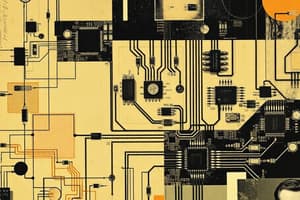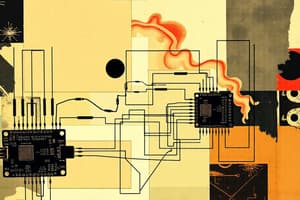Podcast
Questions and Answers
Which of the following statements about I2C and SPI is true?
Which of the following statements about I2C and SPI is true?
- SPI provides acknowledgment for each byte sent.
- I2C requires a slave select pin for communication.
- I2C uses two wires for communication. (correct)
- SPI supports multi-master communication.
What feature distinguishes I2C from SPI regarding data transfer acknowledgment?
What feature distinguishes I2C from SPI regarding data transfer acknowledgment?
- SPI verifies that data is received correctly every time.
- I2C ensures that the data sent is received correctly by the slave. (correct)
- I2C does not support acknowledgment bits.
- SPI provides an acknowledgment bit after every byte.
Which statement accurately describes the power consumption characteristics of I2C and SPI?
Which statement accurately describes the power consumption characteristics of I2C and SPI?
- Both I2C and SPI consume the same amount of power.
- I2C draws less power compared to SPI.
- I2C consumes more power than SPI. (correct)
- SPI draws more power than I2C.
Which of the following is true regarding the communication protocols of I2C and SPI?
Which of the following is true regarding the communication protocols of I2C and SPI?
What is a significant limitation of SPI compared to I2C?
What is a significant limitation of SPI compared to I2C?
Regarding susceptibility to noise, which protocol is generally considered better?
Regarding susceptibility to noise, which protocol is generally considered better?
Which statement correctly describes the arbitration feature in I2C?
Which statement correctly describes the arbitration feature in I2C?
What is the principal difference in wire usage between I2C and SPI?
What is the principal difference in wire usage between I2C and SPI?
Which aspect of I2C communication leads to increased overhead compared to SPI?
Which aspect of I2C communication leads to increased overhead compared to SPI?
What happens when the CCP1 interrupt flag is set?
What happens when the CCP1 interrupt flag is set?
What is the purpose of the line 'movlw b'00000001'' within the Timer1 configuration?
What is the purpose of the line 'movlw b'00000001'' within the Timer1 configuration?
In the code provided, what is the role of the instruction 'BCF STATUS, RP0'?
In the code provided, what is the role of the instruction 'BCF STATUS, RP0'?
How is the PORTA configured before entering the main loop?
How is the PORTA configured before entering the main loop?
What does the instruction 'movf CCPR1L, W' accomplish in the interrupt service routine?
What does the instruction 'movf CCPR1L, W' accomplish in the interrupt service routine?
What is the effect of the instruction 'bsf INTCON, GIE' in the configuration sequence?
What is the effect of the instruction 'bsf INTCON, GIE' in the configuration sequence?
Why is the instruction 'goto mainloop' placed after the interrupt handling?
Why is the instruction 'goto mainloop' placed after the interrupt handling?
What are the functionalities set by the configuration bits in the program?
What are the functionalities set by the configuration bits in the program?
What does 'EQU' signify in the statement 'temp EQU 0x20'?
What does 'EQU' signify in the statement 'temp EQU 0x20'?
In the setup of PORTB, what does setting 'MOVLW 0xFF' achieve?
In the setup of PORTB, what does setting 'MOVLW 0xFF' achieve?
Flashcards
I2C
I2C
A multi-master, multi-slave, half-duplex communication protocol using two wires: clock (SCL) and data (SDA).
SPI
SPI
A full-duplex communication protocol that uses multiple wires (typically 3 or 4) including MOSI, MISO, and SCLK.
Multi-master
Multi-master
More than one device can act as the master (initiator of communication).
Multi-slave
Multi-slave
Signup and view all the flashcards
Half-duplex
Half-duplex
Signup and view all the flashcards
Full-duplex
Full-duplex
Signup and view all the flashcards
Clock Stretching
Clock Stretching
Signup and view all the flashcards
Address-based Protocol
Address-based Protocol
Signup and view all the flashcards
Arbitration
Arbitration
Signup and view all the flashcards
Pull-up Resistor
Pull-up Resistor
Signup and view all the flashcards
PIC16F818
PIC16F818
Signup and view all the flashcards
Configuration Bits
Configuration Bits
Signup and view all the flashcards
XT Oscillator
XT Oscillator
Signup and view all the flashcards
Watchdog Timer
Watchdog Timer
Signup and view all the flashcards
Power-up Timer
Power-up Timer
Signup and view all the flashcards
Code Protection
Code Protection
Signup and view all the flashcards
PORTA
PORTA
Signup and view all the flashcards
PORTB
PORTB
Signup and view all the flashcards
ADCON1
ADCON1
Signup and view all the flashcards
TRISA
TRISA
Signup and view all the flashcards
TRISB
TRISB
Signup and view all the flashcards
CCP1
CCP1
Signup and view all the flashcards
CCP1CON
CCP1CON
Signup and view all the flashcards
CCP1IE
CCP1IE
Signup and view all the flashcards
Capture mode
Capture mode
Signup and view all the flashcards
CCPR1L
CCPR1L
Signup and view all the flashcards
CCPR1H
CCPR1H
Signup and view all the flashcards
PIR1
PIR1
Signup and view all the flashcards
CCP1IF
CCP1IF
Signup and view all the flashcards
GIE
GIE
Signup and view all the flashcards
PEIE
PEIE
Signup and view all the flashcards
ISR
ISR
Signup and view all the flashcards
retfie
retfie
Signup and view all the flashcards
EQU
EQU
Signup and view all the flashcards
Study Notes
I2C vs SPI
- I2C: Can be multi-master and multi-slave (more than one master and slave on the bus)
- I2C: Half-duplex communication protocol
- I2C: Supports clock stretching (slave slows down data transmission if necessary)
- I2C: Uses two wires (one for data, one for clock)
- I2C: Slower than SPI
- I2C: Draws more power than SPI
- I2C: Less susceptible to noise than SPI
- I2C: Cheaper to implement than SPI
- I2C: Uses pull-up resistor
- I2C: Acknowledgment bit after each byte to confirm data transmission
- I2C: Supports multi-master communication (multiple masters on the bus)
- I2C: Multi-master communication protocol with arbitration feature (to resolve contention between masters)
- I2C: Address-based communication protocol (needs a specific address for each slave)
- I2C: Has start and stop bits in communication
- I2C: Supports multiple devices on the same bus without extra select lines. I2C is better for long distances.
- I2C: Developed by NXP
SPI
- SPI: Can be multi-slave but not multi-master (only one master on the bus)
- SPI: Full-duplex communication protocol
- SPI: No clock stretching feature
- SPI: Needs three or four wires (MOSI, MISO, SCL, chip select) for communication (depends on configuration)
- SPI: Faster than I2C
- SPI: Draws less power than I2C
- SPI: More susceptible to noise than I2C
- SPI: Costlier to implement than I2C
- SPI: Doesn't require a pull-up resistor
- SPI: No acknowledgment bit
- SPI: Doesn't verify data transmission correctly
- SPI: Doesn't support multi-master communication
- SPI: Not a multi-master communication protocol; does not have arbitration
- SPI: Needs slave select pin to select a specific slave for communication
- SPI: Does not have start and stop bits
- SPI: Requires extra signal lines (slave select) for multiple devices
- SPI: Better for short distances
- SPI: Developed by Motorola
Studying That Suits You
Use AI to generate personalized quizzes and flashcards to suit your learning preferences.



